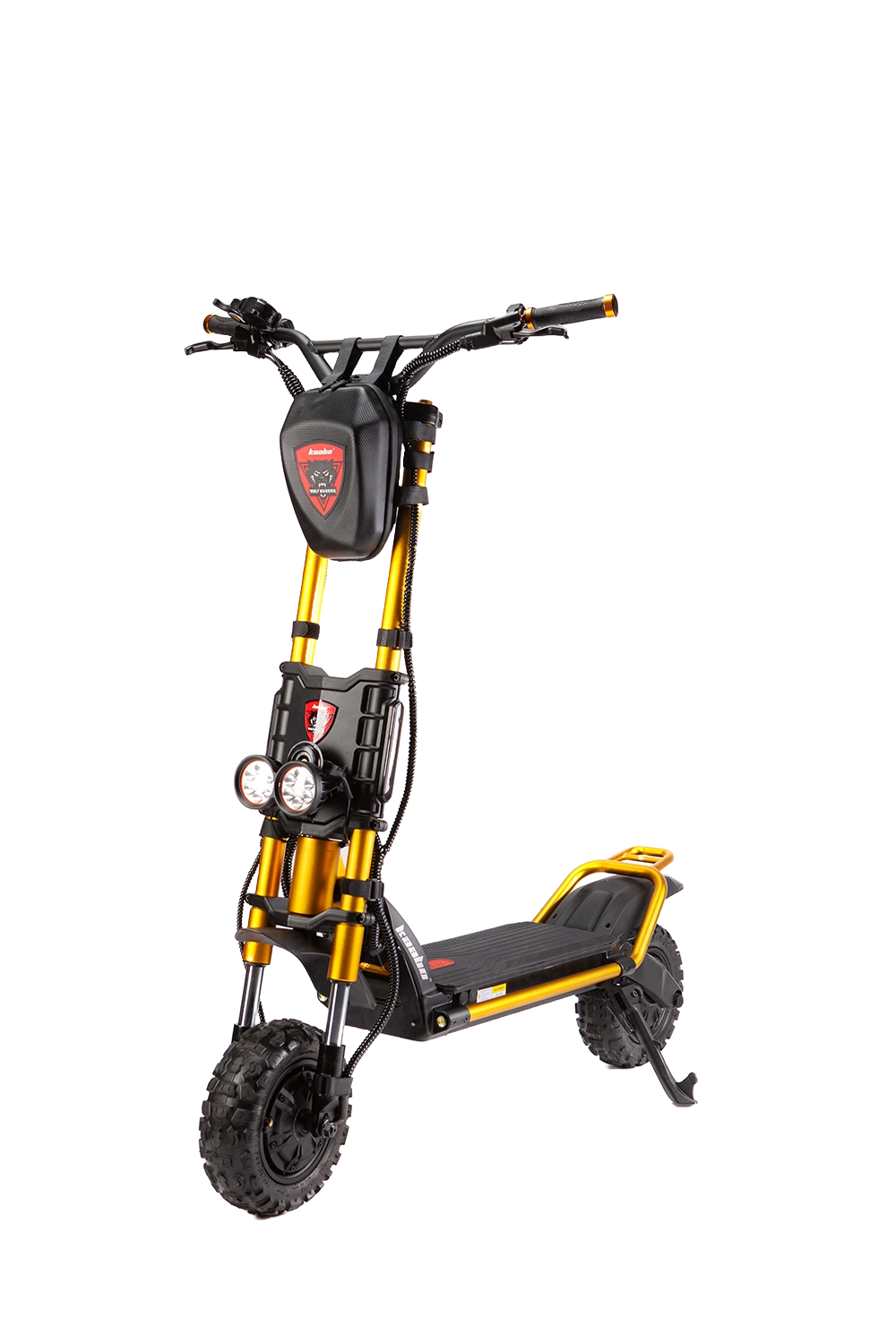tutorials and how-to guides
e-scooters connectors
HiGo Mini-B
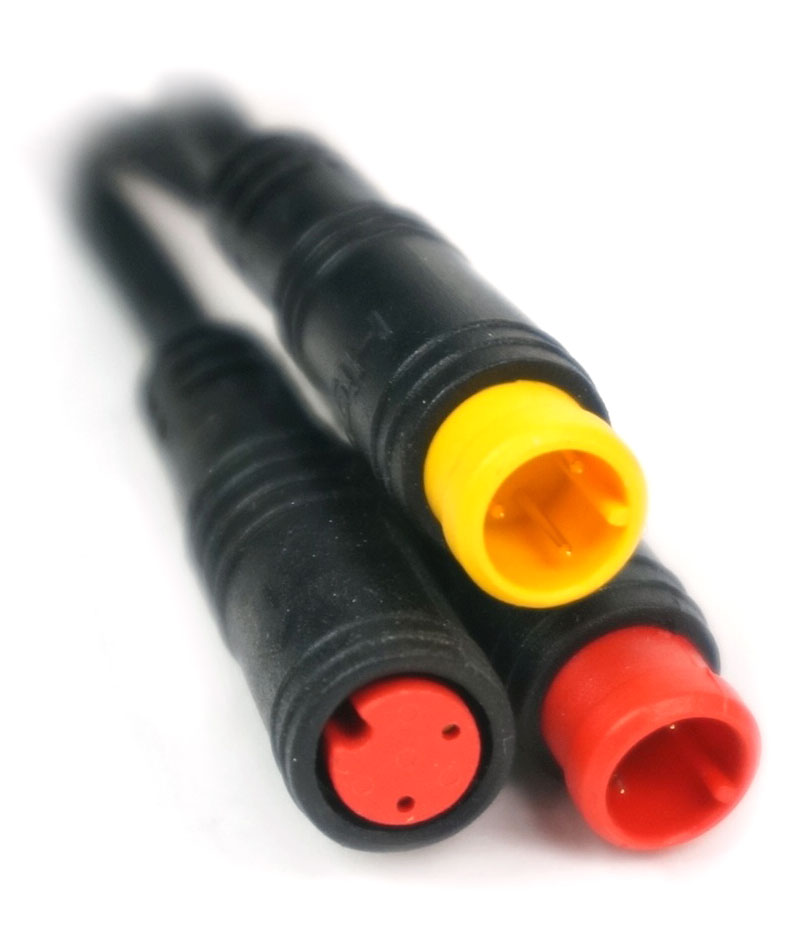 The Higo Mini B signal connector series is an overmolded plug that has been adopted by Bafang and other large volume OEM and turn key ebike manufacturers for various throttle, ebrake, PAS sensor, and light plugs. Compatible version of this plug are also made by Julet and Cusmade. These connectors look and feel great when they come mating in a complete system, but they are not available as a solderable inline plug that anyone can install. The connectors are supplied as premade cable harnesses in the OEM supply line which limits their usage in DIY builds, or as panel mount / PC mount plugs which require custom circuit boards or enclosures.
The Higo Mini B signal connector series is an overmolded plug that has been adopted by Bafang and other large volume OEM and turn key ebike manufacturers for various throttle, ebrake, PAS sensor, and light plugs. Compatible version of this plug are also made by Julet and Cusmade. These connectors look and feel great when they come mating in a complete system, but they are not available as a solderable inline plug that anyone can install. The connectors are supplied as premade cable harnesses in the OEM supply line which limits their usage in DIY builds, or as panel mount / PC mount plugs which require custom circuit boards or enclosures.
While the waterproofing makes the contact reliable, there is no way to measure voltage at the pins when the system is hooked up for diagnostic purposes, and if a pin gets broken from forcing the plugs together incorrectly then there is no avenue for repair either. So while desipte the benefits of reliability and environmental exposure benefits over say JST-SM plugs, they are more of a pain to deal with during troubleshooting and repair.
HiGo Main Signal
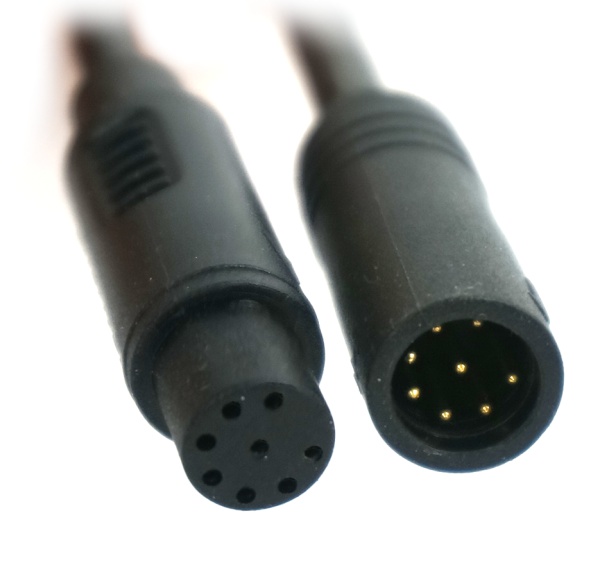 Factory ebikes often have a single connector from the motor that branches out at the handlebar into various plugs for the display, throttle, ebrakes, bike light etc. This Main Cable connector from HiGo is 12mm in diameter and available in 8 to 10 pins, with 8 being the most common. For standard generic bike setups the 8 wires include V+, Gnd, On/Off key, communication lines for the display, 5V, Throttle, and Ebrake lines.
Factory ebikes often have a single connector from the motor that branches out at the handlebar into various plugs for the display, throttle, ebrakes, bike light etc. This Main Cable connector from HiGo is 12mm in diameter and available in 8 to 10 pins, with 8 being the most common. For standard generic bike setups the 8 wires include V+, Gnd, On/Off key, communication lines for the display, 5V, Throttle, and Ebrake lines.
We adopted this same connector standard and a similar pin configuration but different wire colours and gauges for our new CA3-WP devices, which we call the WP8 plug. This allows us to offer a Cycle Analyst that was someone plug in compatible with generic controllers that already have this connector standard, yet still has the same internal wire colours as our 6-pin JST CA plug. Click This Link to see the pinouts. This modified version of the HiGo Z812 is available from Cusmade. Click this link to see the pinouts of the ERider 6 pin HiGo pinout.
Tajima
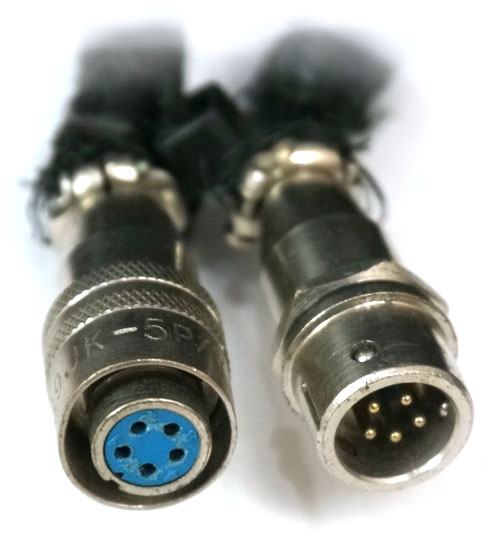
At one point a decade ago Crystalyte switched from using the JST-SM connector for their hall signals to a metalic round 5-pin plug that was erroneously referred to as a “mini XLR”. There actually is such thing as a mini XLR plug, but this particular connector seems to be a knockoff of a Japanese made Tajima connector. At first glance it seemed to be a high quality contact, but in practice had no practical advantage over JST connectors, tended to corrode with exposure, and was a pain to solder. We stopped dealing with these plugs a long time ago, but many other Crystalyte vendors continue to use them.
Hirose DF62
We haven’t seen these used in a commercial ebike application yet, but if we could start over our standards we would have totally chosen this Hirose DF62 series as our preferred small signal connector over the JST-SM. It has all the benefits of the JST-SM in being crimpable, pin extractable, and probeable, with the additional plus of being much more compact and in a profile that seamlessly bleands into the wire with a piece of heatshrink. It can look as sharp as the HiGo plugs without all the downsides of being overmolded. Like the JST-SM series it’s also available in a large number of contacts, from 2 through to 7. And the pins are gold plated too. There is also slightly larger gasketted waterproof version, the DF62-W. Oh where were you 10 years ago.
BMS Header
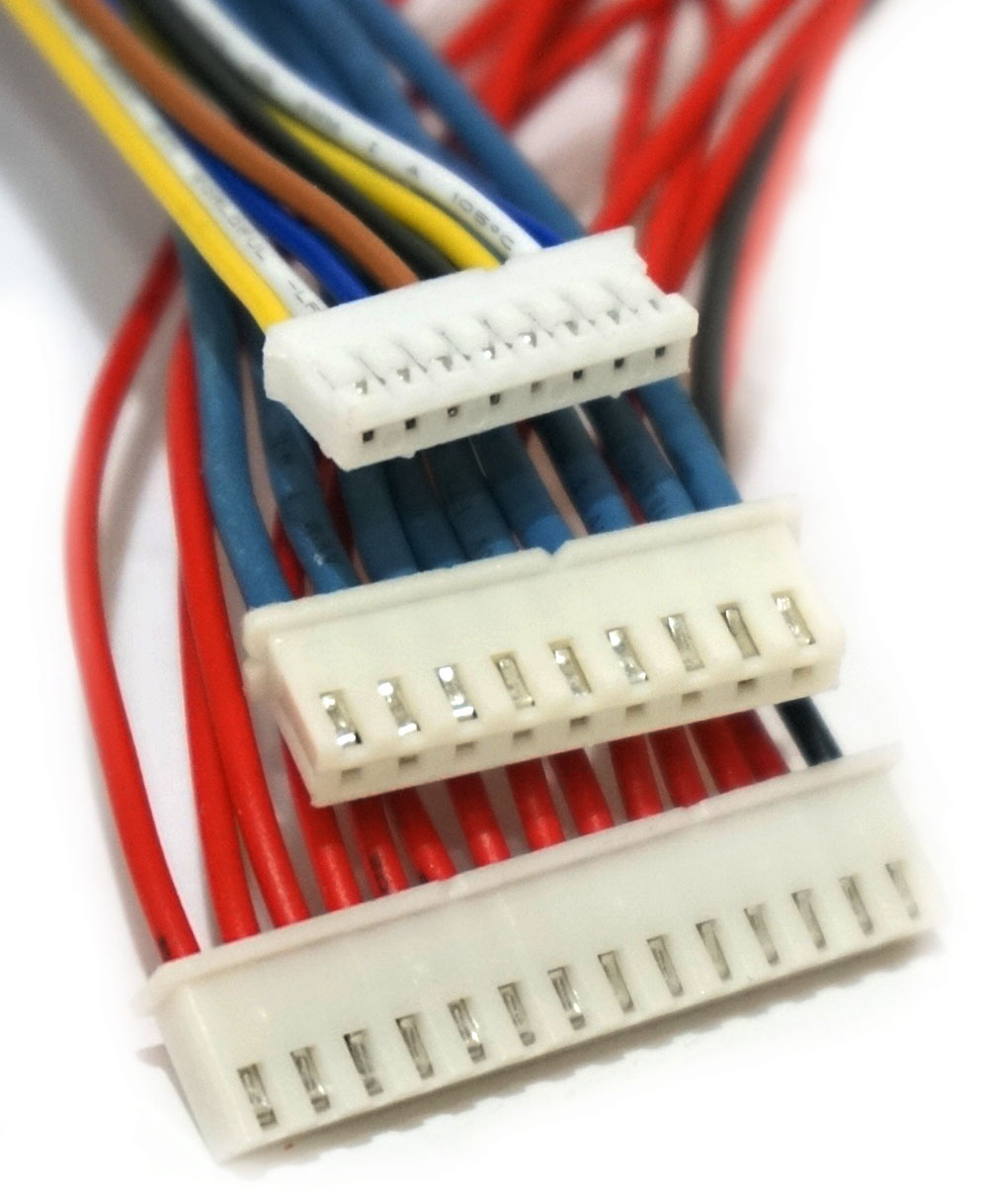 The battery management circuit in a lithium pack needs to connect to all the individual cell tap points, and this is normally done with a single row 10 – 15 pin header connector, which can vary in pitch from 1.5mm to 2.54mm. It’s usually possible to find compatible pins and plugs from digikey or other electronic parts tendors, manufactured by the likes of JST, Molex, Tyco, etc.
The battery management circuit in a lithium pack needs to connect to all the individual cell tap points, and this is normally done with a single row 10 – 15 pin header connector, which can vary in pitch from 1.5mm to 2.54mm. It’s usually possible to find compatible pins and plugs from digikey or other electronic parts tendors, manufactured by the likes of JST, Molex, Tyco, etc.
Molex / Spade
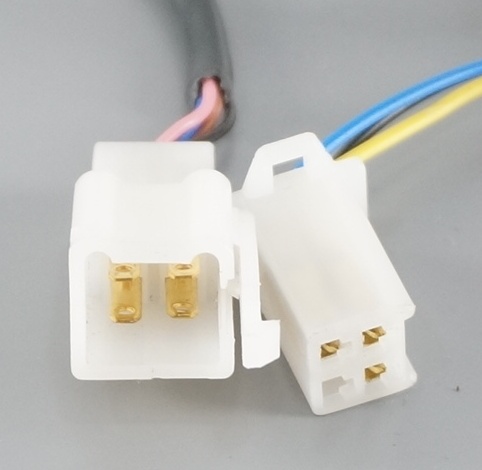 Most Chinese ebikes, scooters, and kits come with large white connectors that have multiple flat spade contacts in them. Basically the cheapest possible connector that is available. They look terrible, but generally work just fine, and in most of these vehicles the connectors are tucked in the chassis and out of sight. Often these get lumped in the general term of Molex connector, but Molex makes all kinds of great connectors and probably not the ones here.
Most Chinese ebikes, scooters, and kits come with large white connectors that have multiple flat spade contacts in them. Basically the cheapest possible connector that is available. They look terrible, but generally work just fine, and in most of these vehicles the connectors are tucked in the chassis and out of sight. Often these get lumped in the general term of Molex connector, but Molex makes all kinds of great connectors and probably not the ones here.
Motor Specific Connectors
HiGo Z910
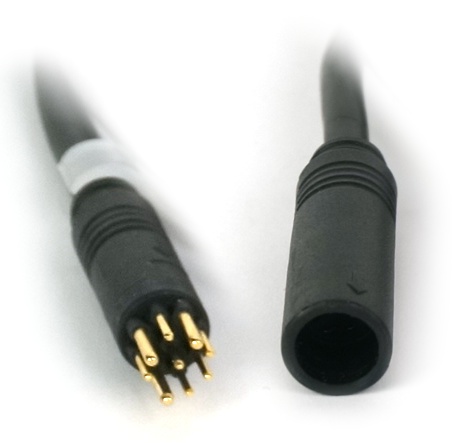 Higo also has an extensive line of overmolded motor connectors that have both the 3 power leads and the hall and other signal wires in a single plug. The Z910 plug is a popular one to find in lower power hub motors systems. It has 3 phase wire terminals good for about 30-40 amps of max current, the 5 hall sensor wires, and a 6th wire that is normally used as a wheel speed sensor in geared motors, or as a motor temperature sensor. Usually this is just called a “9 pin motor” or “waterproof motor” plug, and it has been cloned by a number of other connector companies (see Julet and Cusmade). One of the challenges with a single motor plugs that contains all the phase and hall pins is that the motor hall and phase pin mapping needs to be correct, and as anyone who has mixed and matched different brushless motors and controllers knows this is not always a simple colour to colour matching. Fortunately, since Bafang largely standardized on this connector they have established the meaining of each phase and hall wire so that controllers and motors using this plug from different vendors are largely compatible.
Higo also has an extensive line of overmolded motor connectors that have both the 3 power leads and the hall and other signal wires in a single plug. The Z910 plug is a popular one to find in lower power hub motors systems. It has 3 phase wire terminals good for about 30-40 amps of max current, the 5 hall sensor wires, and a 6th wire that is normally used as a wheel speed sensor in geared motors, or as a motor temperature sensor. Usually this is just called a “9 pin motor” or “waterproof motor” plug, and it has been cloned by a number of other connector companies (see Julet and Cusmade). One of the challenges with a single motor plugs that contains all the phase and hall pins is that the motor hall and phase pin mapping needs to be correct, and as anyone who has mixed and matched different brushless motors and controllers knows this is not always a simple colour to colour matching. Fortunately, since Bafang largely standardized on this connector they have established the meaining of each phase and hall wire so that controllers and motors using this plug from different vendors are largely compatible.
In 2017 we switched over all of our low power kits and 20A controllers and Baserunner_Z9 to use the HiGo Z910 in order to join this standard.
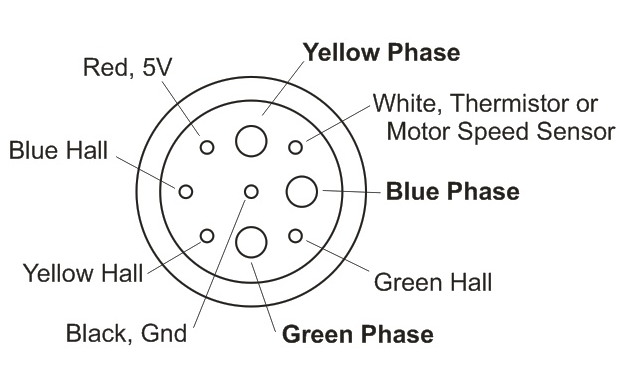
HiGo L10
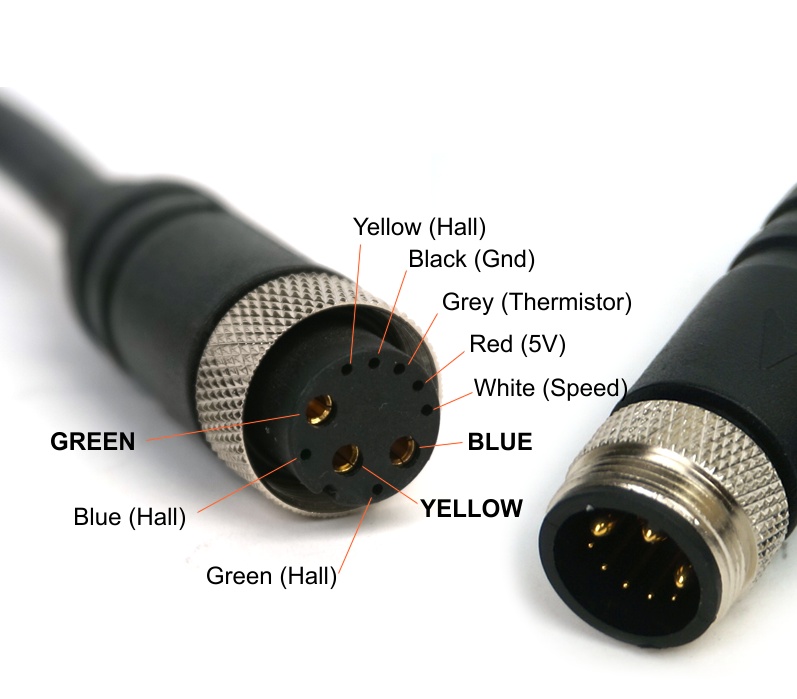 Starting in 2019 we began transitioning all of our mid and high power ebike kits to use the new 10 pin locking L1019 HiGo connector or an equivalent from Cusmade. This connector has much larger phase pins than the Z910 and is available in up to 4mm^2 thick phase wire (slightly larger than 12 gauge) which has shown to be reliable for up to 100A currents for short times. This connector has 7 small signal lines. In addition to the 5 hall pins it allows for both a speed sensor and a motor temperature signal, allowing one plug type that does everything we want. We are using this plug with the same motor hall and phase colour standards as the Z910, and are using the extra white signal wire for motor speedometer, and the extra grey signal for a 10K thermistor. We hope to see this become a new industry norm.
Starting in 2019 we began transitioning all of our mid and high power ebike kits to use the new 10 pin locking L1019 HiGo connector or an equivalent from Cusmade. This connector has much larger phase pins than the Z910 and is available in up to 4mm^2 thick phase wire (slightly larger than 12 gauge) which has shown to be reliable for up to 100A currents for short times. This connector has 7 small signal lines. In addition to the 5 hall pins it allows for both a speed sensor and a motor temperature signal, allowing one plug type that does everything we want. We are using this plug with the same motor hall and phase colour standards as the Z910, and are using the extra white signal wire for motor speedometer, and the extra grey signal for a 10K thermistor. We hope to see this become a new industry norm.
Julet Z916
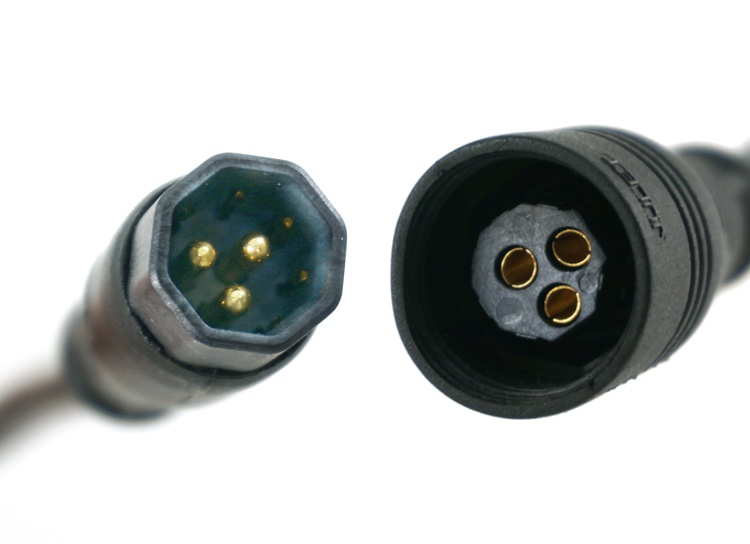 This octagonal style motor plug from Julet has higher gauge wire and larger pins than the Z910 connector, but less current capability than the L1019. It is quite popular for generic mediium power ebikes and kits on the market, including many motors in the Rad Power bike lineup. The connector has 3 phase wires in the middle and 6 signal lines around the perimeter, allowing for an additional motor speed sensor but not a separate speed sensor and temperature sensor like the L1019 plug.
This octagonal style motor plug from Julet has higher gauge wire and larger pins than the Z910 connector, but less current capability than the L1019. It is quite popular for generic mediium power ebikes and kits on the market, including many motors in the Rad Power bike lineup. The connector has 3 phase wires in the middle and 6 signal lines around the perimeter, allowing for an additional motor speed sensor but not a separate speed sensor and temperature sensor like the L1019 plug.
We don’t plan to use this connector in any of our own motors as we find the L1019 to be superior, but given its popularity in existing ebike systems we are looking to make an adapter cable so that people can still have plug and play upgrade options from us.
MT60
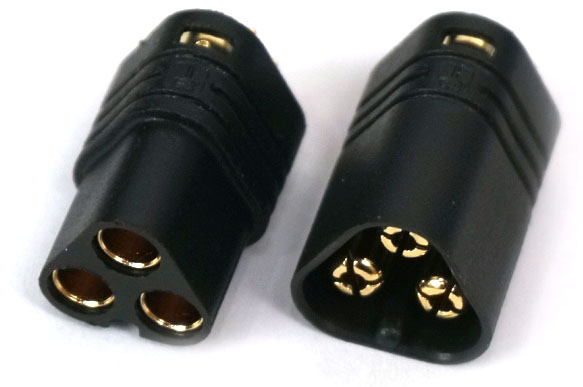
The MT60 is a 3-pin version of the XT60 connector designed for the 3 phase wires of a brushless motor. This plug is more compact than 3 Andersons and can handle the ~100 amp peak phase current of a powerful ebike hub motor without melting. On the downside, you don’t have the flexibility of swapping around the phases to experiment with different pinouts when trying to map a controller to a given motor. And, like the XT60 connectors, it is only available with solder lugs, there are no crimpable pins available so it is much slower to instal. We’ve adopted the MT60 connector as a molded panel mount plug in the updated 2017 Phaserunner devices because the compact size and high current specs allowed us to fit it inside the molding. And when we have customers who run into problems melting anderson plugs on higher power motor phase leads, we usually suggest a switch to the MT60.
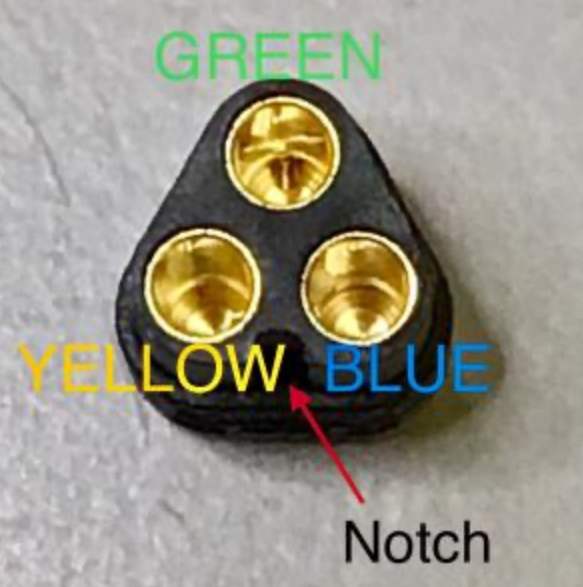
Battery Connectors
Anderson SB50
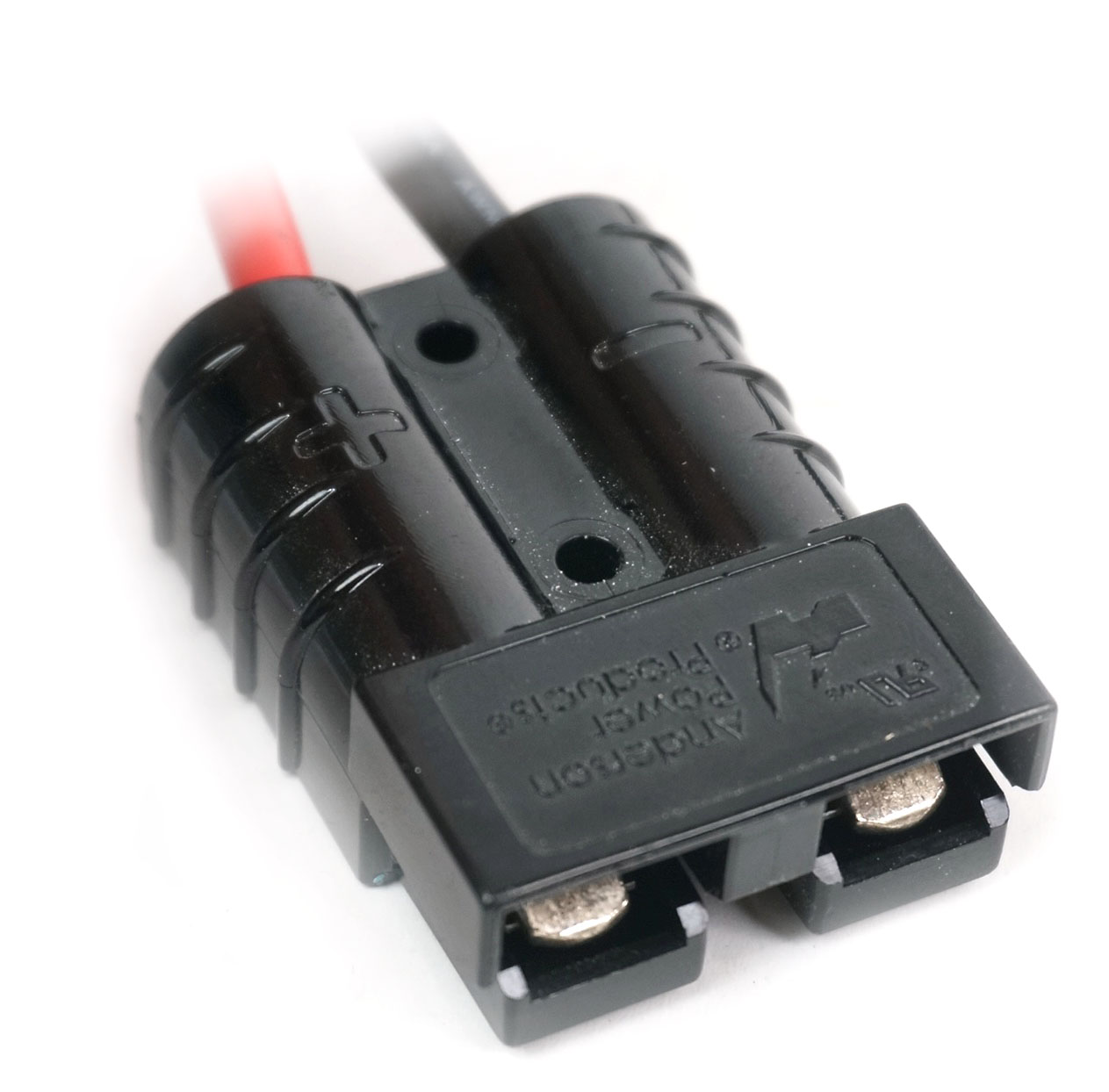 The Anderson SB connectors are popular in larger electric vehicles like golf carts and such but we often see them used with ebike battery packs as well. These connectors are a bit like a larger version of the Powerpole plugs and have the same genderless pin features, but unlike Anderson Powerpoles they lack the modular dovetail jointing system. Instead the Anderson SB connectors are a fixed 2 conductor plug explicitly intended for DC bus cables. In our opinion they are just a little too bulky for use on electric bicycles.
The Anderson SB connectors are popular in larger electric vehicles like golf carts and such but we often see them used with ebike battery packs as well. These connectors are a bit like a larger version of the Powerpole plugs and have the same genderless pin features, but unlike Anderson Powerpoles they lack the modular dovetail jointing system. Instead the Anderson SB connectors are a fixed 2 conductor plug explicitly intended for DC bus cables. In our opinion they are just a little too bulky for use on electric bicycles.
XT60
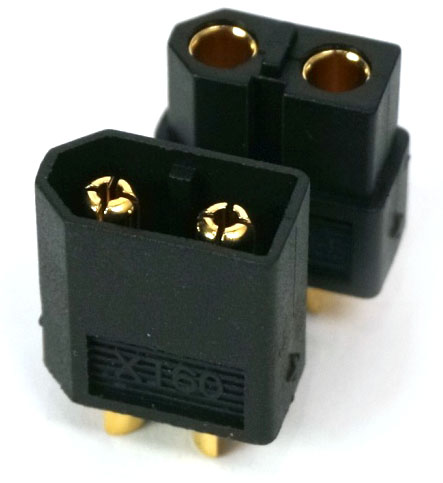
The XT60 is a gold plated 2 conductor 3.5mm bullet connector from Amass designed for the RC market. It has excellent retention force, can handle very high currents without melting (upwards of 100 amps with heavy gauge wire), and is both compact and inexpensive. On the downside, it doesn’t handle arcing connections as well as Andersons and the connector must be soldered, which is much more time consuming and tedious than crimping. It is generally used exclusively as a battery plug, both on the discharge leads and on the charge leads too.
XT90
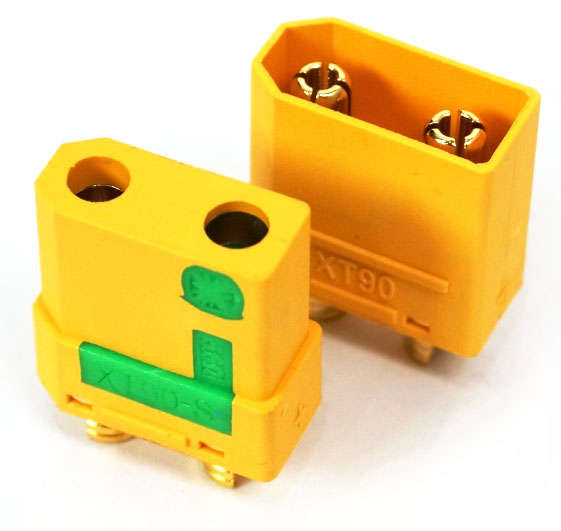
The XT90 connector is a larger version of the XT60 from Amass, with 4.5mm bullet pins for higher currents, conservatively rated at 90A but capable of much more. This connector is uniquely available with a built-in precharge resistor (XT90-S) that eliminates the spark which occurs when plugging in a battery to a capacitive load. That’s a nice touch, although the connector is overkill for most ebike applications that rarely have more than 20-30A sustained battery currents.
Charger Connectors
Rosenberger
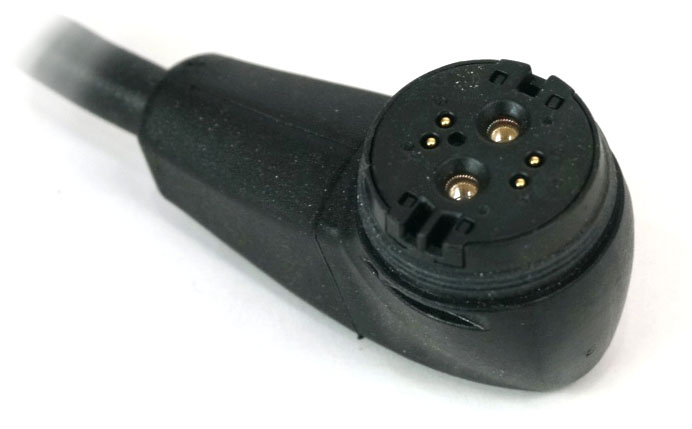
The Rosenberger connector was one of the standards adopted by energybus as a battery plug. It’s got internal magnets to force the correct orientation and hold the connector together, and features two power lines and 4 signal lines, nominally for CANbus. The concept behind this connector to have a universal battery and charger plug that was interchangeable between ebike systems, and a communication scheme that would ensure compatibility. That’s a great concept, but of course the last thing dominant turn-key ebike brands (like Bosch) want is inter-product compatibility.
There was a lot of fanfare for this plug when we attended trade shows around 2014-2015 but it’s not gained much traction that we can see. That may be partly because of its high price, and also because most big players in the industry don’t actually want a standard that works between brands. It is currently used with the Brose system and Specialized ebikes, and in this application only 1 of the signal wires for CANbus is hooked up as a 5V interlock.
XLR
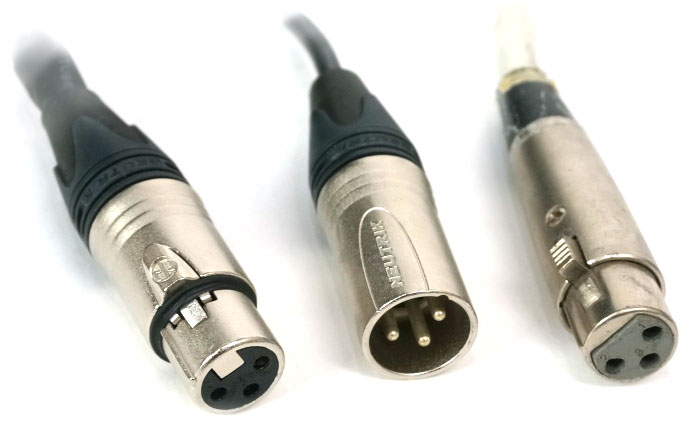
The XLR plug has been used in audio equipment for decades and is available in various pin configurations. In the ebike scene it’s been used on battery chargers since as long as we’ve been doing this (2003). Back then we were mostly dealing with NiMH and NiCad batteries which require a temperature sensor for charging, and so a 3-pin XLR plug was used, with Pin 1 = V+, Pin 2 = Gnd, and Pin 3 = Thermistor. This same 3-pin configuration is also used with lithium and lead acid batteries that don’t require a temperature sensor, and in that case the 3rd pin is either not connected or used as an interlock pin.
Generic quality XLR plugs don’t have very good current handling for their size, and will often melt and distort when used above 4 amps or so. Higher quality XLR plugs like the Neutrik XX brand that we use on the Satiator are rated for 16 amps, which makes it an excellent choice for high current charging.
DC Jack
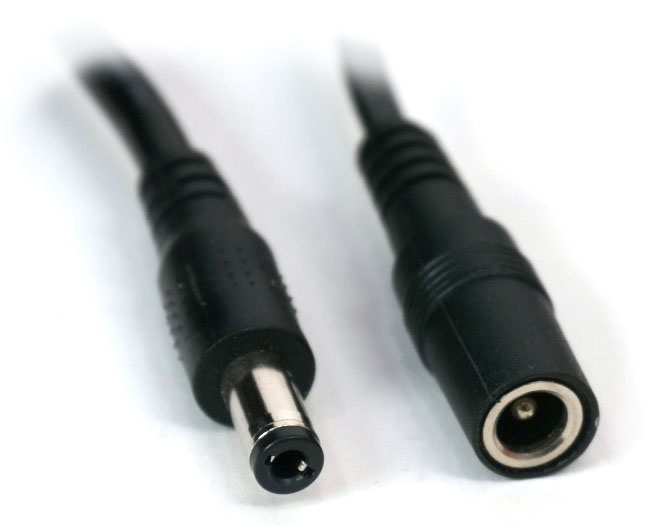
The DC barrel connector has been a standard for powering electronic devices with low voltage DC in consumer electronics, and has found its way as a commonly used plug for the charging port of frame mounted ebike batteries. We have also been using it for many years as the DC power port on the Cycle Analyst for running ebike lights, DC-DC converters, and other accessories.
These DC jack plugs are not usually rated for very high currents, and their design makes it easy to accidentally short the pin and ground tabs with a piece of metal. There are some models that have a multi-prong ground connection and are rated for up to 7 amps, but most of the models are only good for 2-4 amps. This is especially true if the mating contact to the ground sheath is just a single bent metal tab.
The low current rating and vulnerability to shorts make them far from ideal for use as the charge port in an ebike battery pack, but for better or for worse this is a common connector that is in many battery enclosures. Be aware that polarity can vary from device to device and DC plugs are specified by both the diameter of the barrel (OD) and pin (ID). The standard size used in ebikes has a 5.5mm barrel, but the pin can be either 2.5mm (most common) or a smaller 2.1mm (less common).
ST3
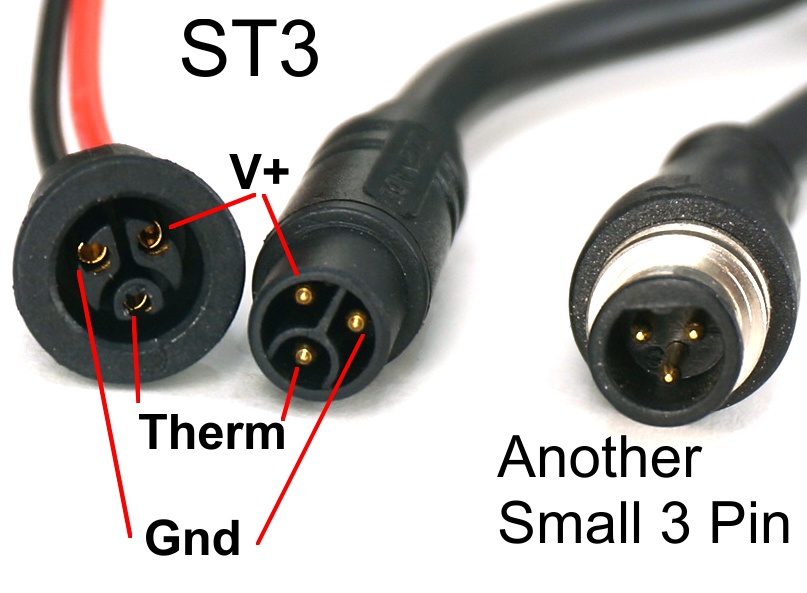
With the limits of the DC barrel connector quite obvious, several manufacturers went about designing a new charging plug standard for ebikes that could fit the same size constraint but support 3 pins and higher currents without any exposed contacts. The 3rd pin allows the use of a temperature sensor inside the battery pack or communincation to a BMS. We know of at least 4 standards like this, some of them look very similar but don’t quite mate up.
We decided in 2019 to adopt the 3 pin plug that the battery charger company ST which was available for us to purchase from cusmade, and since we couldn’t find the formal name for this plug we took to calling it ST3. At present all of our batteries use either the ST3 charge port, or the original 3-pin XLR if the casing supports it.
RCA
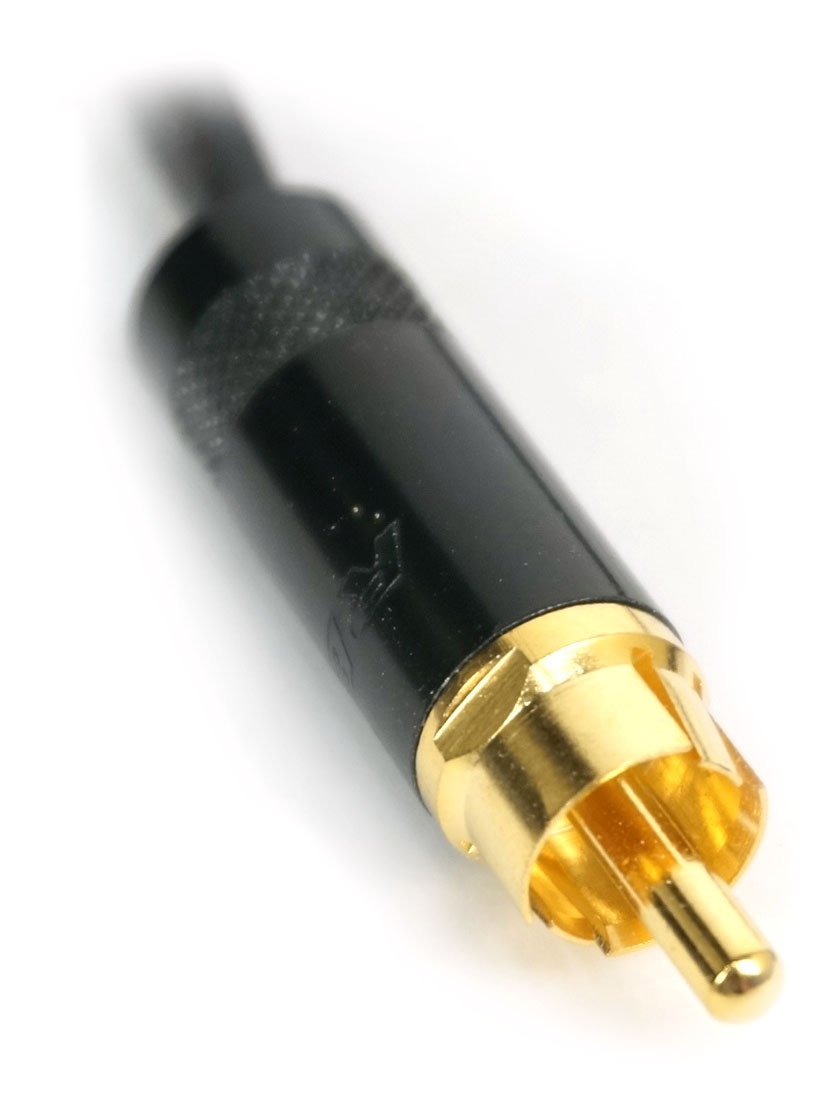 This like the XLR connector is another example of the Chinese ebike battery industry finding an inexpensive connector standard from the audio industry and repurposing it as a charging plug. It is familiar to anyone who has hooked up audio and speaker systems. It has a downside that the pin and sheath are both exposed and easy to short together.
This like the XLR connector is another example of the Chinese ebike battery industry finding an inexpensive connector standard from the audio industry and repurposing it as a charging plug. It is familiar to anyone who has hooked up audio and speaker systems. It has a downside that the pin and sheath are both exposed and easy to short together.
Others:
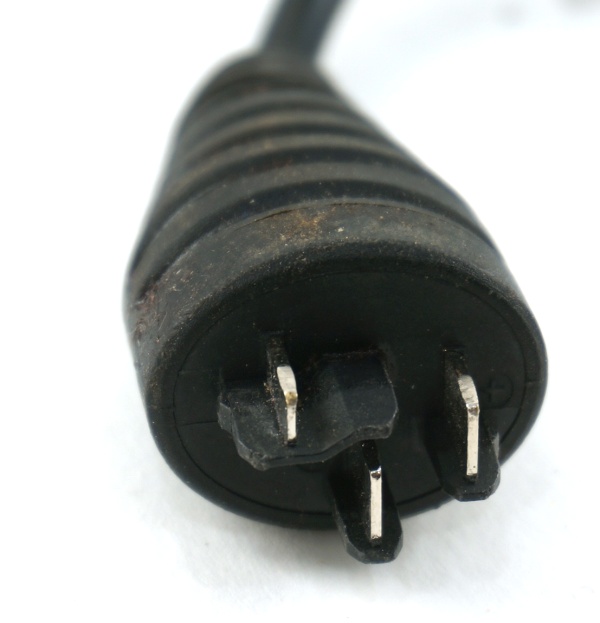
There are countless other connectors from various industries that have found their way both in turn-key ebikes and conversion kits, like the GX16’s and whatnot. People email us all the time asking if we have a product with a compatible plug for their ebike setup, which they might describe in such precise terms as “round” or “square”. That doesn’t help much, and even with a photograph it’s very rare that we’d be able to pinpoint the specific connector model. And to make things even worse, many ebike manufacturers will have their own proprietary connector developed which basically guarantees that you won’t find a compatible 3rd party plug, like Bosch and Shimano have done with their battery charging ports.
Signal Connectors
JST-SM
SM series from JST is a fairly compact (0.1″” pitch) wire to wire connector that has a latch and works excellent for small signals and accessory power up to about 2 amps. This connector is available from 2 pin to 8 pin, making it very versatile for all of the hall sensor, throttle, ebrake, thermistor, PAS, and other multi-pin plugs present in an ebike system.
The connector has the further advantage that you can probe the voltage on the pins while the connectors is plugged in, making it invaluable during troubleshooting (eg identifying a damaged hall signal), and unknown to many people both the female and male pins can be extracted from their housing with a suitable tool (like a bent paperclip). This allows you to remove the pins from the housing if you want to change a wiring pinout or pass the cable through a smaller orifice before reattaching.
On the downsides, this connector is not waterproof, and extensive exposure to water can cause the pins to corrode somewhat, especially any pin with a positive DC voltage on it. Our experience is that even after years of use riding in rainy Vancouver, the connection still remains largely reliable even if the metal pins may look a little weathered.
Pinouts: There are any number of pinout configurations that can be used, so just because two parts from different suppliers have a JST connector with the same number of pins that does not mean that they can safely plug in together. The image below shows the pinout standard that we have currently adopted for all of our components.


